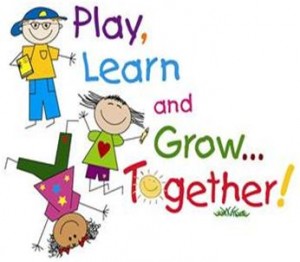Room Arrangements
The equipment in the infant and toddler classroom should be arranged so that the quiet activities are grouped together and the more active and noisy activities are grouped together. Each area should be inviting and contain enough space so that one activity does not interfere with another. The toys can be stored in individually marked containers on marked shelves. Having the shelves labeled will allow the children the opportunity to find the equipment easily, as well as, learning how to return the toys to their proper place. The classroom should be organized with clear paths and defined areas. This will reduce the amount of time children are redirected. Infants should spend the majority of their day exploring their environment. This will allow the children to develop their independence. This cannot happen if the children are continuously place in areas that restrict their movement like high chairs, bouncer, saucers, and cribs.
Make sure that all of the areas of the room are visible and free from obstacles that can cause harm. There should not be any blind spots in the classroom. Create a room that is child friendly and a safe place for the children to move freely. The classroom should have ample space for mobile infants and toddlers to crawl around and safely explore their environment. Make sure that the areas in the classroom provide a variety of opportunities for children to explore different textures and tactile (sense of touch) experiences. Infants and toddlers also require opportunities to climb to develop their gross motor skills. Monitor the classroom and adjust the room based on the successes and weakness of the room arrangement and adjust the room accordingly. Proper utilization of the equipment and space within the classroom will reduce discipline issues.
The Lead Caregiver
The lead caregiver should oversee planning, implementation and evaluation of the classroom program and child assessment. Set the tone and manage the classroom. Create individual lesson plans for the children to address their growth and development. The lead oversees the assistant caregiver that works in the classroom with them. The lead caregiver should work full-time to provide continuity of care for the children.
Primary Caregiver
Primary caregivers provide continuity of care for the infants and toddlers. Each child’s assigned primary caregiver should be documented and provided to the parents. The children should have as few primary caregivers each day and week as possible. This includes the early hours and late hours that the center is open. If a child has more than one primary caregiver assigned throughout the day or week the caregivers should ensure that they share information about the child with each other. The infant and toddler daily logs provided to the parents should include: food intake-time eaten, type of food, and the amount (not some or little), sleep patterns, when and how long a child slept, diaper changes, developmental milestones, and changes in a child’s usual behavior. Providing continuity of care, allows the children, and their primary caregivers the opportunity to develop a nurturing relationship. Infant and toddler appropriate interactions include: holding, rocking, talking to the children, making eye contact, cuddling and interacting, providing guidance to develop social skills, and emotional well-being.





